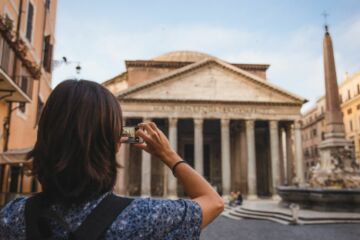
Erasmus Courses for Teachers in Seville, Spain
What is included
More info
Please note that while these services apply to most courses, exceptions may occur. Even in locations where we have dedicated classrooms, we may occasionally need to rent external spaces nearby, and the availability of services may vary. Kids, pets, or guests within the school premises must be approved by email each time. Whether or not our premises are marked as wheelchair accessible, we kindly ask you to inform us in advance. If accessibility is an issue, we will arrange for an external classroom to accommodate your course. If you have any questions, please don't hesitate to reach out to us.
Our Cultural Activities
The following cultural activity is included in the price of each Erasmus course in Spain:
- A half-day or full-day tour on Saturday in Seville
Further information on our activities will be provided after the confirmation of the course.
Our Academy in Seville
All our teacher training courses in Seville will take place either in the Morning (9.00-13.45) or in the Afternoon (14.00-18.45) depending on classroom and trainer availability.
Further information on our Academy will be provided after the course is confirmed.
How to reach us
Seville is served by San Pablo Airport (SVQ), located approximately 10 kilometers northeast of the city center. The airport offers direct flights from many European cities, as well as convenient connections through major European hubs.
is the Airport Bus (EA Line), which costs about €4 one way. The journey takes around 30 minutes and stops at key locations in Seville, including the main bus and train stations.
Alternatively, you can take a taxi, use Uber, or rent a car.
Fiscal data
- OID: E10247545
- PIC: 897217894
- Company name: European Academy of Creativity
- Main address: Rambla de Catalunya 15, 2º2ª, 08007, Barcelona, Spain
- NIF: B67520866
- Responsible Person: Dr. Alessandro Pumpo, Director
- Email: teacheracademy@europassnetwork.eu; admin.spain@europassnetwork.eu
- Phone: +39 055 1997 3220 / +34 626924733
Erasmus Courses in Seville
All courses in Seville
The 8Rs of Environmental Education and Sustainability
Capture Cities’ Cultural Heritage with Video Reportage
Conflict Management for School Staff
Boosting Creative Thinking and Problem Solving
Cultivating Self-Leadership: The 8 Cs for Personal Growth and Success
Global Education and Critical Media Literacy: Essential Elements in Contemporary Teaching
Best Things to Do in Seville

Seville, the capital of Andalusia, is a city where history and vibrant local life intertwine. Originally a Roman settlement that later flourished under Moorish rule, Seville boasts a captivating mix of Roman, Moorish, and Gothic influences, seen in landmarks like the Alcázar and the Giralda Tower.
The city’s Golden Age began in the 16th century when it became the main port for trade with the Americas, bringing wealth and a dynamic mix of cultures that shaped its identity.
Today, Seville offers visitors an immersive experience of Spanish culture. From the passionate art of flamenco in neighborhoods like Triana to the countless tapas bars serving Andalusian specialties, the city delights with music, dance, and flavors.
Exploring its winding streets, visitors will find vibrant plazas, traditional ceramic shops, scenic river views, and historic buildings, making Seville an unforgettable journey through Spain’s rich heritage and lively spirit.
1) Real Alcázar

The Real Alcázar is an architectural masterpiece that showcases the exquisite artistry of Moorish Spain. Originally a Muslim fortress, it later became a royal palace. Visitors can marvel at the intricate tilework, domed ceilings, and sprawling gardens filled with fountains and lush vegetation.
Make sure to book tickets in advance here to avoid long lines. Highlights include the Patio de las Doncellas, known for its sunken garden, and the Hall of Ambassadors, where some of Spain’s most significant historical events were held.
2) Seville Cathedral and Giralda Tower
Seville Cathedral, one of the world’s largest Gothic cathedrals, reflects Sevilla’s layered history, with its origins as a 12th-century mosque transformed into a Christian church in the 15th century.
Inside, grand altars, art-filled chapels, and Christopher Columbus’s tomb await. The Giralda Tower, originally a minaret, features ramps instead of stairs for horseback access and offers stunning city views.
3) Santa Cruz District
The historic Santa Cruz District, Sevilla’s former Jewish quarter, invites visitors to wander its narrow, cobbled streets, lined with whitewashed buildings, plazas, and hidden courtyards. Highlights include the peaceful Jardines de Murillo and the Baroque Hospital de los Venerables, now an art exhibition space.
4) Plaza de España

Built for the Ibero-American Exhibition in 1929, the Plaza de España is one of Sevilla’s most iconic landmarks. This impressive, semicircular square is surrounded by a canal with four bridges representing the ancient kingdoms of Spain.
Along the plaza, 48 intricately tiled benches represent each Spanish province, each telling a story through colorful azulejos (ceramic tiles). This is a great place to take a rowboat ride or simply relax and people-watch.
5) Casa de Pilatos
Casa de Pilatos, a 16th-century palace, beautifully merges Mudejar, Gothic, and Renaissance architectural styles. The palace’s central courtyard is adorned with a stunning fountain, surrounded by classical statues and archways.
Its gardens are equally charming, providing a serene escape. Casa de Pilatos is an excellent example of the eclectic influences that define Sevilla’s architecture, creating an ambiance of old-world elegance.
6) Archivo General de Indias
This UNESCO World Heritage site is housed in a Renaissance building and offers a fascinating glimpse into Spain’s colonial empire. Established in the 16th century, the archives contain documents detailing the exploration and conquest of the Americas.
The building itself is a striking example of Renaissance architecture and provides a wealth of historical insights into the Spanish Empire’s reach and influence.
7) Metropol Parasol (Las Setas de Sevilla)

Built in 2011, Metropol Parasol is one of Sevilla’s most modern landmarks. Known as Las Setas (the Mushrooms), this large wooden structure was built over Roman ruins and offers panoramic views of the city.
The design consists of six parasol-like structures, creating a unique visual contrast to the historic architecture of Seville. Visitors can take an elevator to the top for sweeping views, visit the Roman ruins below, or enjoy a drink at the rooftop bar.
8) Triana District and the flamenco
Across the Puente de Isabel II, the Triana District offers a lively experience of Seville’s flamenco and artisan traditions. Known as the birthplace of flamenco, Triana is a hub for this passionate art form, with performances in intimate venues.
Visit the Mercado de Triana for fresh produce, ceramics, and textiles, or explore the local shops selling traditional pottery. Triana also hosts the Castillo de San Jorge, a medieval fortress offering a glimpse into the city’s historical defense systems.
9) Maria Luisa Park

Sevilla’s green oasis, Maria Luisa Park, is a beautiful space filled with fountains, flower beds, and shaded walkways. It is home to two museums – the Archaeological Museum, featuring artifacts from ancient civilizations, and the Museum of Popular Arts and Traditions, dedicated to Andalusian culture and customs.
The park is perfect for a relaxing stroll or a picnic, offering a refreshing break from the city’s bustling streets.
10) Museo de Bellas Artes
Housed in a former convent, the Museo de Bellas Artes is one of Spain’s most important art museums. Its collection spans medieval to 20th-century Spanish art, with notable works by artists such as Murillo, Velázquez, and Zurbarán.
The museum’s setting, with peaceful courtyards and spacious galleries, provides an ideal backdrop for appreciating Spanish masterpieces.
11) Plaza de Toros

Seville’s historic bullring, also known as la Maestranza, dates back to the 18th century and is one of the most significant plazas de Toros in Spain. It includes a museum that explores the history, costumes, and artistry behind the sport.
Despite controversies, bullfighting has (had?) an undeniable cultural significance in Spain and visitors here may gain insight into this longstanding tradition.






